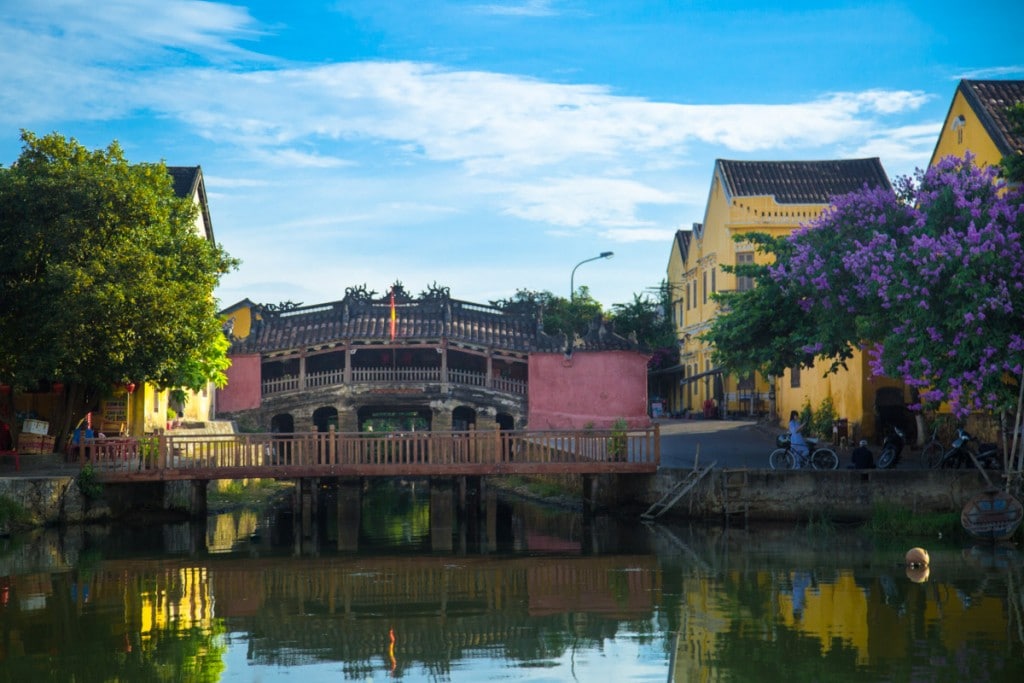How to get from Hanoi to Hoi An?
Getting to Hoi An
Vietnam can be quite challenging to explore, especially for first-time travelers. Most common knowledge about public transport does not apply here. Trains can be more expensive than flights, buses require seat reservations, most stations appear chaotic, official prices are difficult to find, and scams are frequent.
Hoi An is located 798 kilometers south of Hanoi. Typically, you have a 17-hour drive to cover the distance and a 1 hour and 20 minutes flight to reach the nearest airport, Da Nang.
Fortunately, there are several ways to get to Hoi An from Hanoi. Depending on your budget and time constraints, you can opt for a bus, train, plane, or even a motorcycle, each with its pros and cons.
The bus and the motorcycle will take you directly to Hoi An, while the train and the plane will take you to the city of Da Nang, just 30 kilometers north of Hoi An. From Da Nang, you are a short ride (45 to 90 minutes) away from Hoi An, by local bus, express shuttle, taxi, or private car.
Hanoi to Hoi An by Bus

If you choose to travel by bus, you will spend about 18 hours in a sleeper bus. They are a bit more comfortable than regular buses. Most of them have reclining seats or beds, Wi-Fi, a TV, and charging outlets. There are many companies that will take you directly from Hanoi to Hoi An. However, it is also quite difficult to determine which are the good ones and how to avoid being overcharged.
Sinh Tourist and Hung Thanh Travel are the two companies preferred by locals. Both have daily buses departing from Hanoi at 6 PM. If you decide to go directly to Hoi An, your ticket will cost about 320,000 VND and you will arrive between 11 AM and 1 PM the next day. You take the bus from their offices in Hanoi and will be dropped off at their offices in Hoi An.
Bus Stop
You also have the option to stop at major cities along the designated routes (Ninh Binh, Phong Nha, Hue, and Da Nang). This way, you can see more of the country and break up your journey into smaller sections. An open ticket costs a bit more than a standard ticket (570,000 VND).
If you choose this option, make sure to check the bus route, as not all buses stop in the same cities. Remember to book a seat for the next leg of your journey a few days in advance. If you wish to save on your trip to the bus offices, the easiest way to book your ticket is to speak to the receptionist at your hotel or your host. They will usually book the ticket for you and explain all the details. Travel agencies are also a popular option and usually offer a hotel pick-up service in the old town area.
- Advantages
Sleeper buses are the cheapest way to travel in Vietnam. Their prices are very attractive, especially for last-minute or budget travelers, and they can be a good alternative to the train. Their biggest advantage is the “Open Tour” option.
By purchasing an open bus ticket, you can get on and off buses in major cities along the route. The advantage of the open ticket is that you can spend more time in places you like and less time in those you don’t. It’s the ideal way to see more of Vietnam and travel spontaneously without hassle.
- Disadvantages
If you go directly to Hoi An, you will spend almost an entire day on a bus. Between the onboard music, the bumpy roads, and the horns, you might have trouble sleeping.
Earplugs and eye masks are highly recommended. Moreover, there are no toilets on the bus, so you will have to wait for the next stop.
Hanoi to Hoi An by train

There is no train station in Hoi An. The nearest station is Da Nang, which receives several trains per day from Hanoi. From Da Nang to Hoi An, you will need to use another mode of transport. It’s a very short journey with many options available for all budgets. The train journey from Hanoi to Da Nang takes between 15h 30m and 16h 30m. Most travel agents and hotels will buy you a train ticket for a small commission. But you can also buy it online through 12goasia.
I recommend buying your tickets at least one day in advance to ensure a seat or bed. Plan even more time during the busy holiday season. Seat types include a hard seat (wooden seat), soft seat (airplane seat), fixed berth (6 berths, 3 tiers in a cabin) and soft berth (4 berths, 2 tiers in a cabin).
Ticket prices vary depending on the train, the fastest being the most expensive. The lower berth is the most expensive, while the upper berth is the cheapest. Prices generally start at 396,000 VND for a hard seat, 520,000 VND for a soft seat, 749,000 VND for a fixed berth, and 943,000 VND. If you want to travel in luxury, VIP options with four berths are available, costing 2,005,000 VND per bed.

They offer the most comfortable environment and a more stylish way to travel. You can also send your motorcycle to all major coastal cities, including Vinh, Dong Hoi, Hue, and Da Nang. However, you do not travel with your motorcycle; it goes on a separate freight train. From Hanoi, it will take up to two days to arrive in Da Nang, and will cost about 530,000 VND.
- Advantages
The Vietnamese railway system offers a reliable, affordable, and relaxing way to travel across the country. The route linking Hanoi to Hoi An offers spectacular landscapes and excellent views of the coast. It’s a great mode of transport for those looking to see a bit more of Vietnam in a comfortable way. Traveling in an air-conditioned sleeping berth is definitely worth a bumpy night bus on the QL1A highway.
- Disadvantages
Vietnamese trains are aging. Although they are quite reliable, do not expect to find modern, ultra-fast, spotless, European-type trains here. If you are only staying a few days in Vietnam, spending 17 hours on a train may not be the best option for you, whether in terms of time or comfort.
Hanoi to Hoi An by Plane

Flying is probably the simplest option. There are several daily connections between Hanoi and Da Nang. The nearest airport to Hoi An is Da Nang, and the flight from Hanoi only takes 1h20. From Da Nang, it will take you between 40 and 90 minutes to reach Hoi An, depending on your mode of transport.
- Advantages
A plane is undoubtedly the fastest and most comfortable way to get to Hoi An. If you book in advance, it’s also one of the cheapest. Flights start at 560,000 VND. The three local airlines, Jetstar Pacific, VietJet.Air, and Vietnam Airlines, rank first for safety. We flew with Jetstar Pacific Airlines on a budget and found it very comfortable and punctual.
- Disadvantages
Jumping from one city to another by plane makes it difficult to explore a destination. If you want to see more of Vietnam, traveling by bus, train, or motorcycle will take you through its landscapes, giving you a better idea of what the place really has to offer and allowing you to visit more places along the way.
Hanoi to Hoi An by Motorcycle

Another popular option for getting to Hoi An from Hanoi is by motorcycle. Do not dismiss this option just because you do not own a motorcycle in Vietnam. Many motorcycle shops operating throughout the country offer “one-way” rental options. This simply means that you can start your journey in one city and leave the bike in another.
https://stylemotorbikes.com/ has shops in Hanoi and Hoi An, with a wide range of motorbikes, meaning you can rent your motorbike in Hanoi and drop it off in Hoi An. Daily rates start at 230,000 VND, while monthly rates start at 4,370,000 VND.
To rent, you must pay a security deposit or leave your passport with them. Security deposits start at 13,800,000 VND. I advise you not to leave your passport with them, as even though they will send it to your final destination, hotels in Vietnam require a passport to guarantee a room.
You can travel worry-free (driving license)
Although you do not need to show your driving license to rent a motorcycle from Style Motorbikes (they offer free driving lessons to inexperienced drivers), I highly recommend having a valid driving license before riding a motorcycle. Roads in Vietnam can be crowded, unpredictable, and dangerous.
The country has one of the highest road mortality rates in the world, 15,500 deaths per year, what is called “Vietnam’s hidden epidemic”. It is clear that this is not the country to learn to drive and no insurance will cover you with an invalid driving license, if the worst should happen.
Easy and fast rental motorbike
Rentals come with a helmet. A wide stock of helmets and safety equipment is also available for sale. Recommended routes with marked highlights are also available for download on your phone. The journey is close to 800 km or 15 hours of driving. The inner Ho Chi Minh Trail offers breathtaking landscapes of mountains, rivers, and local villages.
It will only take you one hour more on the road, but you will have avoided the intense truck and bus traffic on the more direct coastal route of highway QL1A. I highly recommend not going directly to Hoi An and taking at least three to four days to enjoy the scenery offered. Reservations are generally encouraged as shops are often out of motorcycles. You can contact them directly via Facebook or email. Payments are made in cash or by credit card. You can also use PayPal for the security deposit.
- Advantages
When you ride a motorcycle through Vietnam, it’s more about the journey than the destination. You get total freedom and your own customized itinerary. You decide how many days you want to spend on the road and which stops you want to make along the way. If you enjoy riding on the back of a motorbike, traveling half the country, from Hanoi to Hoi An, is a great way to see this diverse country and experience an untouched Vietnam.
- Disadvantages
Roads in Vietnam are as unpredictable as its climate. If you travel halfway across the country, you will encounter poor quality roads, roads in bad condition, heavy traffic, roadside markets, livestock, stormy rains, and cold conditions. Make sure you are prepared for this adventure, as riding in Vietnam is more than just “sunny beach vacations”.







